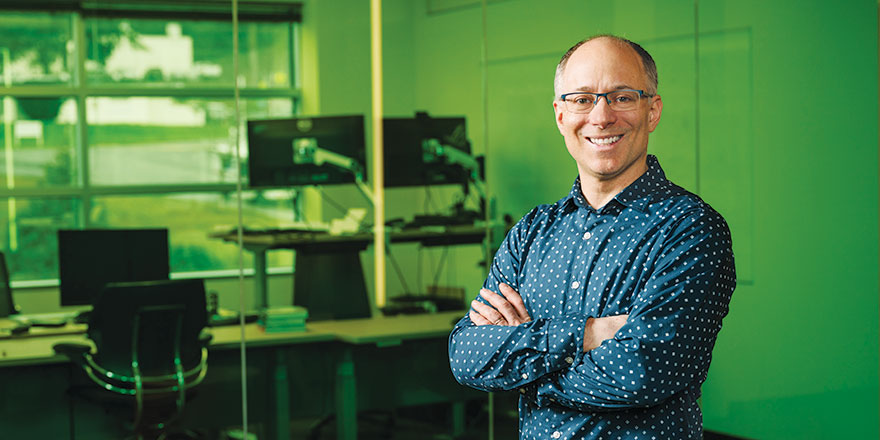True Chemistry: How Aaron Lefohn ’97 Found His Calling in Tech
Lefohn climbed his way to an innovative tech career after first discovering computing at Whitman
By Casey Brown
Photography by Kim Fetrow ’96 of Kim Fetrow Photography

Aaron Lefohn ’97 chose Whitman College because it was academically selective—and it had a vibe he liked. At the time, he had no idea how much that decision would affect his life and inventive career path.
“When I visited Whitman, the scene of people studying hard, playing Ultimate Frisbee on Ankeny, and enjoying Whitman’s outdoor rock climbing wall—it just seemed like a challenging and welcoming place for the next step in my life,” Lefohn says.
Today, Lefohn is Vice President of Graphics Research at NVIDIA, a technology company at the forefront of what he describes as accelerated computing. NVIDIA, founded 30 years ago, is a leader in 3D computer graphics, artificial intelligence, autonomous vehicles and other fields and products that rely on innovative and accelerated computing.
A Chemical Reaction
At Whitman, Lefohn earned his degree in Chemistry. After graduating, he went on to earn master’s degrees in chemistry and computer science from the University of Utah and a Ph.D. in computer science from the University of California, Davis (UC Davis).
Whitman gave Lefohn his first exposure to computing—and it was a chemical reaction of sorts—a bond that stayed with him. As an undergraduate, he encountered the emerging field of computational chemistry, which uses computer simulations to solve chemistry research problems.
During the summer before his senior year, he took the advice of then Professor of Chemistry Stephen Schvaneveldt and taught himself the programming language C++.
“Computer programming captured my interest like none of my academic classes had before.”
Then during his senior year, he worked with Professor Schvaneveldt. “For my senior thesis research, I built a Monte Carlo computer simulation of a noble gas. This was my first experience simulating physical processes with a computer, which is still an integral part of my current research at NVIDIA.”
As a doctoral student in chemistry at the University of Utah, Lefohn took every opportunity he could to pursue his growing interest in computer science.
“I discovered that as a graduate student, I could take classes in any department. I started signing up for computer science classes as a chemistry graduate student.”
It was in those side courses that he “finally figured out what I wanted to be when I grew up,” Lefohn says.
A scientist, yes—a computer scientist studying computer graphics.
Lefohn left his graduate chemistry program with a master’s in chemistry and was accepted into University of Utah’s master’s program in computer science. Lefohn went on to win a National Science Foundation graduate fellowship and complete his Ph.D. in computer science at UC Davis.
A Framework for Success
At NVIDIA, where he works in the regional office in Redmond, Washington, Lefohn has found a company where his drive to explore new possibilities and technologies is both welcome and woven into the culture.
“It’s an incredible environment in which to be an inventor. The company has an insatiable appetite for new ideas, supports long-term research and has extraordinarily strong product teams eager to partner with researchers to bring new ideas to market,” he says.
Lefohn’s post-graduate education gave him the capabilities he needed to pursue a career in tech. Yet he attributes his success as an inventor—in an industry that requires research, critical thinking and innovation—to his Whitman education.
“One of the things I learned from Whitman was how to learn,” he says.
“I credit Professor Templeton for teaching me the foundations of the scientific process. Teaching us how to perform repeatable and accurate scientific experiments, teaching us how to thoroughly document our science, and overall being rigorous, careful and inquisitive scientists.”
Other early lessons at Whitman have stayed with and served Lefohn.
“I don’t know what life would have been like without that broad liberal arts background. Out of the collection of things that I learned at Whitman, one of the most important is how to write,” he says. “I rely on those skills every day.”
Keep Climbing
If Lefohn wasn’t studying or in the lab at Whitman, he would likely be at the climbing wall or on a mountain excursion with the Outdoor Program.
“The Whitman climbing community was like an unofficial sports team. We were at the climbing wall four days a week and traveling to climb outdoors on many weekends.”
Lefohn met his wife, Karen Gamache, at Whitman—thanks to climbing and calculus.
“We met in Professor Fontenot’s Calculus III class, and then she came on a rock climbing trip that friends and I were guiding to Smith Rock State Park in Oregon. She’d always wanted to learn how to climb. After that trip, she started tutoring me in calculus, and we started climbing together.”
Lefohn isn’t one who gives up on any challenge easily, whether it’s inventing or climbing.
“I spent over two years working on climbing one particular route at Smith Rock before I was able to finally climb it without falling,” he says.
That same intensity and persistence serve him today when it comes to facing difficult research problems.
“Climbing taught me that solving hard problems requires a long-term commitment, grit and mental strength. When a climb seems impossible, you dig deep, you look inside yourself and discover you’ve got far more to give, and you just keep pushing through.”